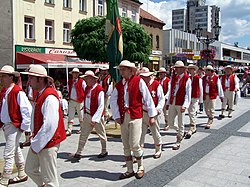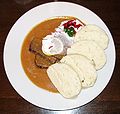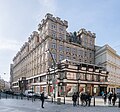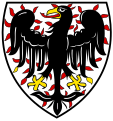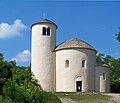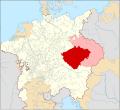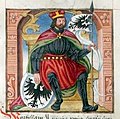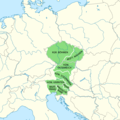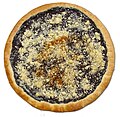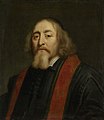Portal:Czech Republic
Welcome to the Czech Portal!
Vítejte na Českém portálu!

|

|
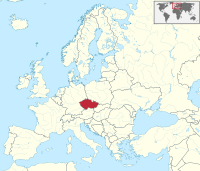
| |
The Czech Republic, also known as Czechia, is a landlocked country in Central Europe. Historically known as Bohemia, it is bordered by Austria to the south, Germany to the west, Poland to the northeast, and Slovakia to the southeast. The Czech Republic has a hilly landscape that covers an area of 78,871 square kilometers (30,452 sq mi) with a mostly temperate continental and oceanic climate. The capital and largest city is Prague; other major cities and urban areas include Brno, Ostrava, Plzeň and Liberec.
The Duchy of Bohemia was founded in the late 9th century under Great Moravia. It was formally recognized as an Imperial State of the Holy Roman Empire in 1002 and became a kingdom in 1198. Following the Battle of Mohács in 1526, all of the Crown lands of Bohemia were gradually integrated into the Habsburg monarchy. Nearly a hundred years later, the Protestant Bohemian Revolt led to the Thirty Years' War. After the Battle of White Mountain, the Habsburgs consolidated their rule. With the dissolution of the Holy Roman Empire in 1806, the Crown lands became part of the Austrian Empire.
In the 19th century, the Czech lands became more industrialized, and in 1918 most of it became part of the First Czechoslovak Republic following the collapse of Austria-Hungary after World War I. Czechoslovakia was the only country in Central and Eastern Europe to remain a parliamentary democracy during the entirety of the interwar period. After the Munich Agreement in 1938, Nazi Germany systematically took control over the Czech lands.
Czechoslovakia was restored in 1945 and three years later became an Eastern Bloc communist state following a coup d'état in 1948. Attempts to liberalize the government and economy were suppressed by a Soviet-led invasion of the country during the Prague Spring in 1968. In November 1989, the Velvet Revolution ended communist rule in the country and restored democracy. On 31 December 1992, Czechoslovakia was peacefully dissolved, with its constituent states becoming the independent states of the Czech Republic and Slovakia.
The Czech Republic is a unitary parliamentary republic and developed country with an advanced, high-income social market economy. It is a welfare state with a European social model, universal health care and free-tuition university education. It ranks 32nd in the Human Development Index. The Czech Republic is a member of the United Nations, NATO, the European Union, the OECD, the OSCE, the Council of Europe and the Visegrád Group. (Full article...)
Selected article -
The Polish minority in the Czech Republic is a Polish national minority living mainly in the Trans-Olza region of western Cieszyn Silesia. The Polish community is the only national (or ethnic) minority in the Czech Republic that is linked to a specific geographical area. Trans-Olza is located in the north-eastern part of the country. It comprises Karviná District and the eastern part of Frýdek-Místek District. Many Poles living in other regions of the Czech Republic have roots in Trans-Olza as well.
Poles formed the largest ethnic group in Cieszyn Silesia in the 19th century, but at the beginning of the 20th century the Czech population grew. The Czechs and Poles collaborated on resisting Germanization movements, but this collaboration ceased after World War I. In 1920 the region of Trans-Olza was incorporated into Czechoslovakia after the Polish–Czechoslovak War. Since then the Polish population demographically decreased. In 1938 it was annexed by Poland in the context of the Munich Agreement and in 1939 by Nazi Germany. The region was then given back to Czechoslovakia after World War II. Polish organizations were re-created, but were banned by the Communist Party of Czechoslovakia. After the Velvet Revolution Polish organizations were re-created again and Trans-Olza had adopted bilingual signs. (Full article...)Selected picture
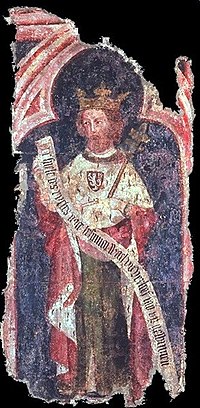
Source: www.bildindex.de; License: Public domain
In this month
- 1 May 2004 – The Czech Republic joins the European Union
- 9 May 1974 – The Prague Metro begins operation
- 14 May 1855 – The book The Grandmother by Božena Němcová is released
- 27 May 1942 – An assassination attempt (pictured) on acting Reichsprotektor Reinhardt Heydrich in Prague as part of Operation Anthropoid results in him dying on 4 June – the villages of Lidice and Ležáky are razed to the ground in response
- 29 May 1975 – Gustáv Husák becomes President of Czechoslovakia, remaining in office until 1989
Categories
Selected biography -
Tomáš Rosický (Czech pronunciation: [ˈtomaːʃ ˈrosɪtskiː]; born 4 October 1980) is a Czech former professional footballer who was the captain of the Czech Republic national team for a ten-year period. He played club football for Sparta Prague, Borussia Dortmund and Arsenal. Currently, he serves at the sports director of Sparta Prague.
A midfielder, he started his professional career at his hometown club Sparta Prague, playing three seasons in the Czech First League before moving to Borussia Dortmund in 2001 for DM 25 million (approximately £8 million), at the time a record transfer fee paid by a Bundesliga club. In his first season in Germany, he helped his team win the league title and reach the 2002 UEFA Cup Final. Rosický joined Arsenal in 2006, and made 247 appearances for the club, including appearing in their victory in the 2014 FA Cup Final. He spent a total of ten seasons in the Premier League, affected by several long-term injuries. (Full article...)Did you know?

- ... that in 2005 UNESCO proclaimed the Moravian male recruit dance verbuňk as part of the Intangible Cultural Heritage of Mankind?
- ... that the report Public Finance Balance of Smoking in the Czech Republic found that the "effect of smoking on the public finance balance in the Czech Republic in 1999 was positive"?
- ... that, having played 465 league matches, Jaroslav Šilhavý holds the record for the most appearances in top-flight Czech football?
- ... that Czech actress Anna Letenská was killed by the Nazis for her alleged participation in the assassination of Reinhard Heydrich?
General images
Related portals
Topics

Czech lands: Bohemia • Moravia • Czech Silesia
History: Únětice culture • Boii • Marcomanni • Samo • Great Moravia • Přemyslid dynasty • Lands of the Bohemian Crown • Czech lands (1526–1648) • 1648–1867 • 1867–1918) • Czechoslovakia • Czech Republic
Geography: Lakes • Protected areas • Regions • Rivers
Law: Judiciary • Law enforcement • Supreme Court of the Czech Republic
Politics: Administrative divisions • Government • Constitution • Elections • Foreign relations • Army • Parliament • Political parties • President • Prime Minister
Economy: Banks • Czech koruna • Energy • Oil and gas deposits • Stock Exchange • Tourism • Transport
Culture: Architecture • Art • Cinema • Cuisine • Demographics • Education • Language • Literature • Media • Music • Philosophy • Prostitution • Public holidays • Religion • Sport • Television • Video games
Symbols: Flag • Coat of arms • National anthem (Kde domov můj)
Lists: Outline of the Czech Republic • List of Czech Republic–related topics
WikiProjects
Featured and good content
Things to do
Wikimedia
The following Wikimedia Foundation sister projects provide more on this subject:
-
Commons
Free media repository -
Wikibooks
Free textbooks and manuals -
Wikidata
Free knowledge base -
Wikinews
Free-content news -
Wikiquote
Collection of quotations -
Wikisource
Free-content library -
Wikiversity
Free learning tools -
Wikivoyage
Free travel guide -
Wiktionary
Dictionary and thesaurus


